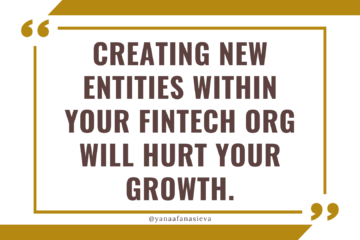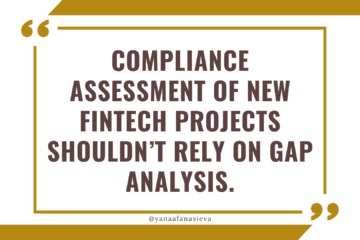How FinTechs Make Money: An Overview of Several Popular Pricing Models
In this newsletter, I’d like to share with you my observations about the types of financial and pricing models that are easier to present and defend, when you are submitting your licensing or regulatory plans. I will also talk about the types of business models and financial projections that typically cause challenges and pushbacks.
What do I mean by “business models” or “pricing models”? This is the answer to the question of how your startup makes money, the structure of your fees, and how you determine your pricing.
The best, simplest, and easiest business models within FinTech are pricing models that are based on:
Fees per transaction, interest fees, minimum monthly fees, interest charges, and fees for late payments 💸
- PayPal charges merchants a fee for each transaction they receive, it also charges senders for sending money to friends and family as well as it charges buyers foreign exchange fees when they shop in currencies they don’t have.
- Coinbase charges a fee for each cryptocurrency transaction that is processed on its platform. Coinbase custody is a service that provides institutional investors with secure storage for their cryptocurrency assets. Coinbase charges a fee for this service.
- Klarna charges merchants a fee for each transaction that is processed using its service. The fee is typically a percentage of the transaction amount, plus a fixed fee. Klarna earns interchange fees from credit card companies when its customers use credit cards to make purchases. Klarna also charges interest on purchases that are financed over time. It also charges late fees if payments are not made on time.
- eToro charges overnight fees for positions that are held open overnight. These fees are based on the interest rate differentials between the two currencies in the trade.
- eToro’s CopyTrader feature allows users to automatically copy the trades of other successful traders on the platform. eToro earns revenue by charging a small commission on the profits earned by users who copy successful traders.
Buy/sell activities, proprietary trading, or margins-based models
- eToro earns revenue by charging spreads and commissions on trades. The spreads represent the difference between the bid and ask prices of an asset, while the commissions are charged as a percentage of the trade value.
- Most crypto exchanges and many investments firms engage in proprietary trading
Subscriptions (e.g. for premium services)
- Klarna offers a subscription service that gives customers access to its services for a monthly fee.
- Robinhood Gold premium subscription service offers features such as margin trading and instant deposits for a monthly fee.
- Betterment is a robo-advisor and it offers a premium subscription service that includes personalized financial advice and guidance from certified financial planners for a yearly fee.
- Stash is an investment app that offers a subscription service called Stash+, which includes additional features such as a debit card with rewards and access to investment accounts for family members for a monthly fee.
- eToro offers premium accounts to users who meet certain criteria, such as high trading volumes or account balances. These accounts come with additional features and benefits, and eToro charges a fee for access to these accounts.
Minimal monthly or annual fees 💰
- Banks often charge minimal monthly fees for checking and savings accounts, as well as for ATM use and overdraft protection.
- Credit card companies charge monthly or annual fees for their cards.
- Insurance companies charge monthly premiums for their policies.
The more complex models that often trigger a lot of questions and may cause pushback from the regulators involve the following:
Advertising revenues or referrals or affiliate commissions
- Robinhood earns money using payments for order flows, e.g. by routing customers’ trades to market makers who pay Robinhood for the right to execute those trades. The market makers pay Robinhood a fee in exchange for the order flow. This practice has been criticized by some who argue that it creates conflicts of interest. Robinhood also offers a financial news and education service called Robinhood Snacks. This service provides daily news updates and analysis of the stock market, and it generates revenue through advertising partnerships with companies that are featured in the news.
- Credit Karma is a personal finance company that offers free credit scores, credit reports, and credit monitoring services to its customers. The company earns advertising/referral fees by promoting credit cards, loans, and other financial products to its users.
- Bankrate is a financial advice website that offers information on mortgages, credit cards, savings accounts, and more. The company earns advertising fees by promoting financial products to its users.
- Mint is a budgeting and personal finance app that helps users track their spending and manage their finances. The company earns advertising fees by promoting financial products, such as credit cards and savings accounts, to its users.
Inactivity fees
- eToro charges inactivity fees on accounts that have been inactive for 12 months or more.
- Interactive Brokers charged at some point an inactivity fee of $20 per month on accounts that have less than $2,000 in equity and have been inactive for 12 months or more.
- Charles Schwab charges an inactivity fee on accounts that have a balance of less than $5,000.
- Kraken charges an inactivity fee of $10 per month on accounts that have not placed a trade or have no open positions for 12 months or more. It’s worth noting that some cryptocurrency companies may have minimum balance requirements or other account maintenance fees that may apply.
Investing customer balances
- Robinhood earns interest on some cash balances that customers hold in their Robinhood accounts. They pool the cash balances and invest them in various interest-bearing instruments such as Treasury bonds.
- Robinhood earns revenue by lending out its customers’ shares to short sellers. When Robinhood lends out shares, it charges a fee to the borrower, and the revenue generated is shared with the customer who owns the shares.
What are the primary financial metrics regulators, investors, and auditors will analyze when reviewing your FinTech business model and financial projections:
- Processed Volumes
- Net Revenue (1-3% of processed volumes is common)
- User retention or ratio of active/inactive users (ideally above 50%)
- CAC (cost of customer acquisition)
Important metrics for subscription businesses:
- Monthly (MRR) or Annual Recurring Revenue (ARR)
- Growth Rate: monthly or annually
- User Monthly Retention
- CAC
Why advertising revenues and commissions in the financial industry are problematic? 🤔
- Typically these platforms require a lot of social engagement and user-generated content, which makes it harder to ensure that information about the product is accurate and unbiased.
- Users are the product being sold, but they are not the real customer of the platform.
- Registered users are a vanity metric, the platform needs a lot of clicks and impressions to remain profitable.
- Daily and monthly active users are important metrics.
- Retention is less critical.
- Cost per click is an important metric.
If you are in the process of applying for (or got stuck with) a FinTech license or preparing your business and financial documentation to secure a financial partnership, consider investing in my FinTech Compliance Self-Starter Package!
This product is right for you if:
- Your company is just getting started and you don’t want to create all your compliance policies from scratch.
- You are in the process of mandatory revisions of all your existing policies and want to benchmark your policies to some of the industry’s best practices.
- You need to prepare a lot of compliance documents as a result of applying for a FinTech, EMI, PI of VASP license or preparing for a FinTech white label partnership.
- Your existing policies have been randomly created by different people at different times, lack consistency and structure, and it’s time to get your house in order and consolidate everything so that you can successfully pass the next regulatory audit.
My templates are tested by dozens of FinTech professionals and hundreds of participants have joined my workshops and shared raving reviews. The actual compliance activities suggested and the risk acceptance framework embedded into the policies are the outcomes of my “just in time” (as opposed to “just in case”) approach to compliance.
Compliance That Makes Sense cannot be learned at regulatory seminars or from reading laws and circulars. It comes from the practice of working with agile dynamic FinTechs, just like yours, who are pressed for time and have a limited budget.
Well, if you are a smart action-taker, click here and get started with simpler compliance than ever before.
Please let me know if you have any questions about this package or how to use it!
Don’t miss this fresh episode on Compliance That Make Sense podcast today! Listen now! 🎧


